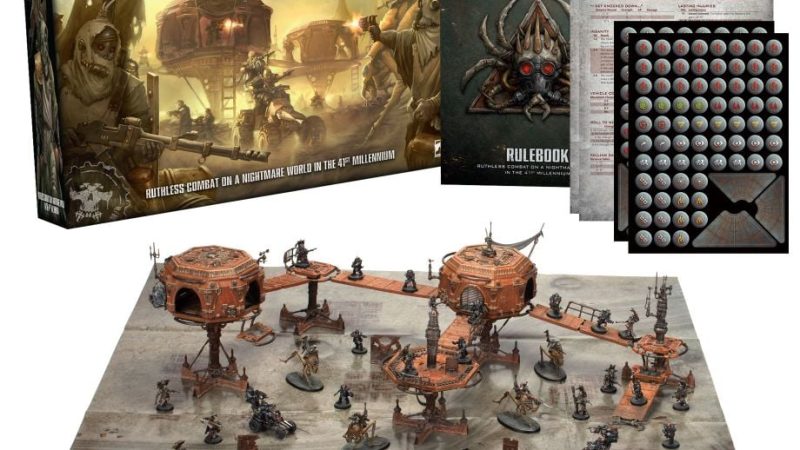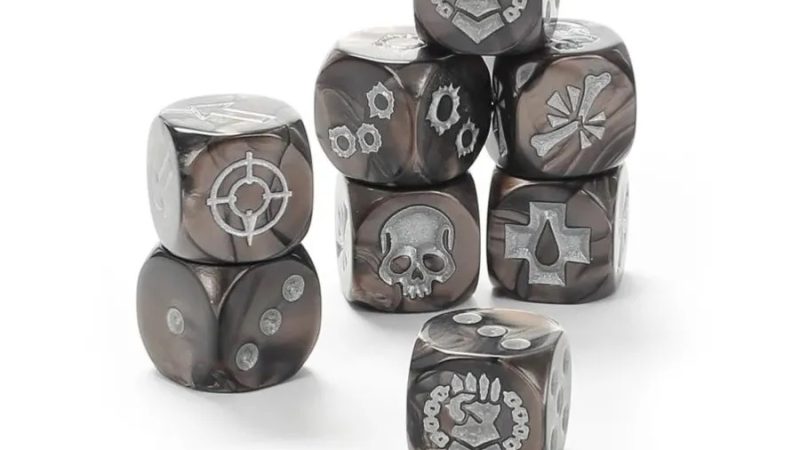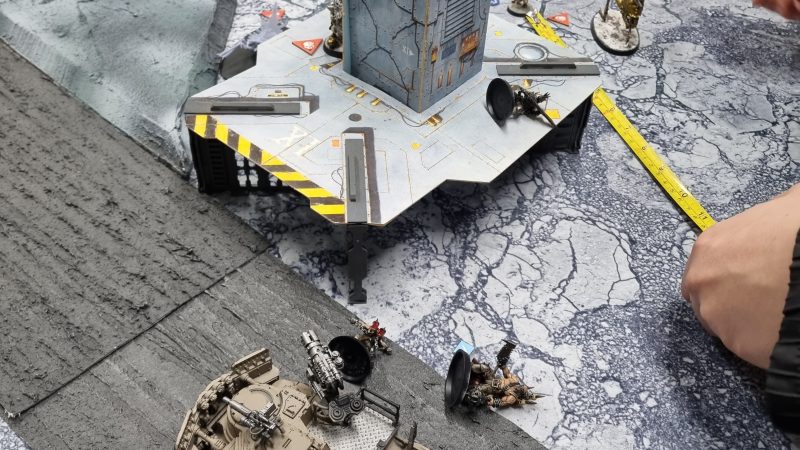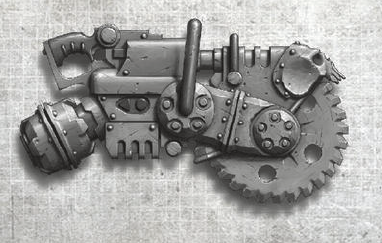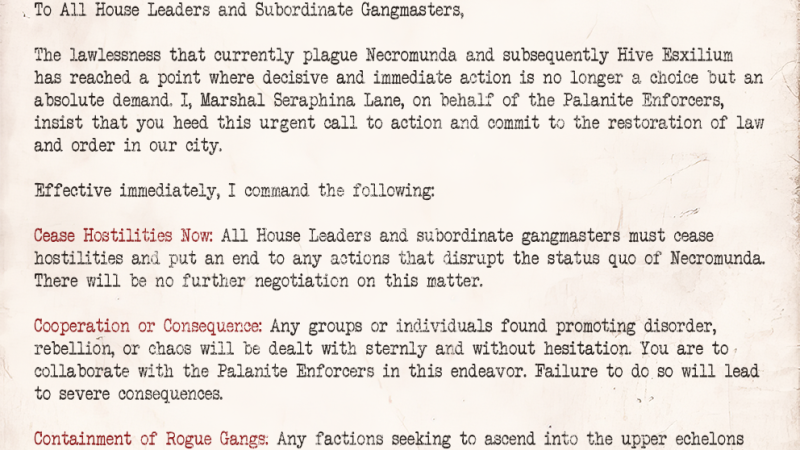The Essential Guide to Multiplayer Scenarios for Necromunda (Arbitrator’s Perspective)
Hey there, Necromunda enthusiasts and Arbitrators alike!
In this article, I’ll take a closer look at multiplayer games and what you should consider when designing those kinds of scenarios, as well as how you can make the most of them! We all love a good multiplayer game. It’s fantastic to gather together to play Necromunda, but it can feel like a tedious exercise if you play it like an ordinary game due to the mechanical nature of Necromunda’s rules, which can seem counterproductive for a multiplayer game. After all, you’ll likely have a strong narrative output for your campaign with a multiplayer game. Enough introduction – let’s dive in!
What Multiplayer Scenarios Are Already Out There?
We often forget how many Necromunda scenarios Games Workshop has published over the years. Quite a few are multiplayer scenarios, and I’ve played a bunch of them. These scenarios provide all the rules and streamlining necessary for a multiplayer context. However, you might want to adapt these scenarios to accommodate more players or fit your campaign narrative. So, take a look at them and get inspired!
- GANG MOOT
A gang parlay gets bloody! - PIT FIGHT
In this scenario, gangs put forward their best fighters in order to try to win a large prize. - ESCAPE THE HIVE
Having outgrown life in the Underhive, a powerful gang has decided to follow rumours of a more bountiful home amongst the stars. Their many long-time enemies decide that now is their last chance to settle some scores. - MEEEEEEEEEAT!
A group of survivors is surrounded by crazed cannibals! - DAEMONIC POSSESSION
A Daemon is loose within the hive. - MEAT FOR THE GRINDER
To prove their worth in a society turned even more savage and ruthless, the weakest members of the gang must fight it out. - URBAN RENEWAL
In this scenario the gangs are attempting to be the first to bring down a dome, ideally while causing lots of damage to their rivals. - WAR IN THE SHADOWS
Scouts fight it out to gain a toehold for their gangs. - END TIMES
The last hours of the hive are at hand and all that remains is for the remaining survivors to battle it out to the bitter end. - THE LAST ROUND
A powerful gang celebrates their final victory at a local drinking hole – only to discover the fight is not over yet… - GATEWAY TO HELL
A gang tries to escape from the authorities into the wastes – though the hive will not let them go so easily. - THE LONG NIGHT
Gangs must fight to survive a sector-wide shutdown, battling darkness, cold, critters and each other until the artificial dawn comes. - NECROMUNDAN DOUBLE-CROSS
In this scenario, a group of gang leaders and champions are set up and betrayed by one of their rivals.
What Should You Consider As an Arbitrator When Organising a Multiplayer Event?
Not sure if it’s a 100% fit but I reckon the 5W1H might be of use here. You should ask yourself the following questions:
- Where can I have enough room and terrain to cater for a multiplayer game?
- What sort of multiplayer game do I want?
- Why is a multiplayer scenario necessary?
- When is an appropriate time in my campaign to set up a multiplayer game?
- Who is likely to attend?
- How can this work?
Where Can I Organise a Multiplayer Game?
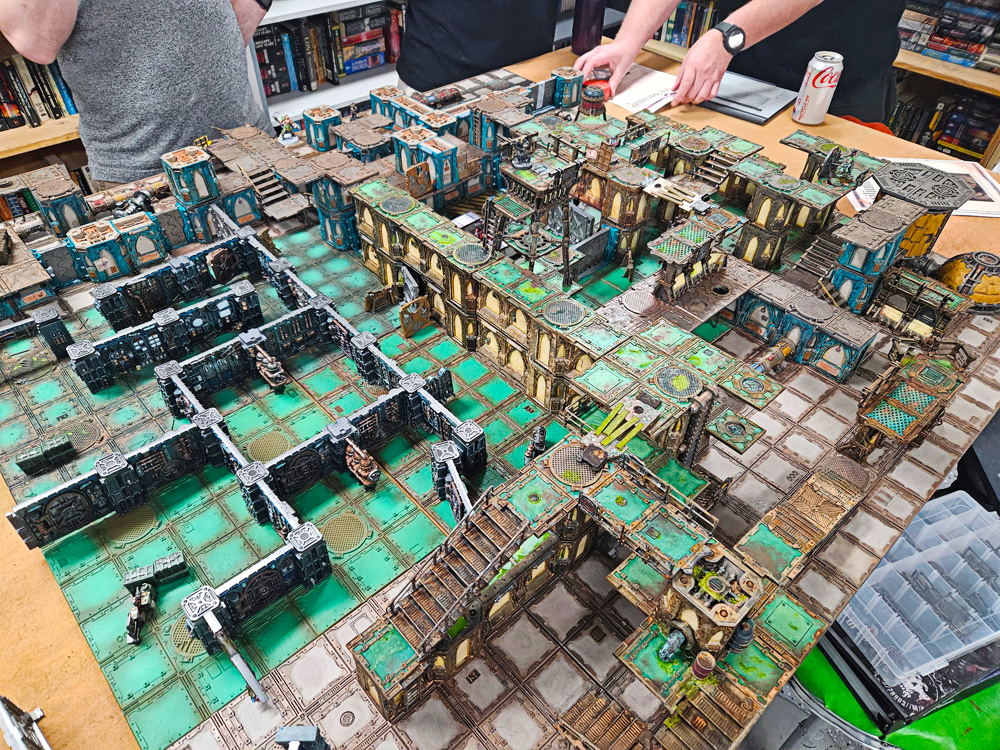
This might sound like a silly question because most people would answer: anywhere! But the reality is a bit different. You’ll want to have a suitable venue or a large room and table at home to set up a big enough board. Multiplayer games don’t necessarily have more minis than a regular game, but they tend to play better on a bigger battlefield. A 4’x4′ board is ideal if you have more than four players. If the action is too packed, it becomes incomprehensible, and if the terrain is too cramped, someone will inevitably knock it over.
Regarding terrain, you’ll need quite a lot to fill up the board. While a large board usually requires ample terrain, a multiplayer game will need even more than what you’d use for a two-player game of the same battlefield size. Ensure you have enough barricades and bridges to allow safe deployment zones for each gang and a smooth flow of movement and actions between many deployment zones and points of interest.
What Sort of Multiplayer Game Could You Run?
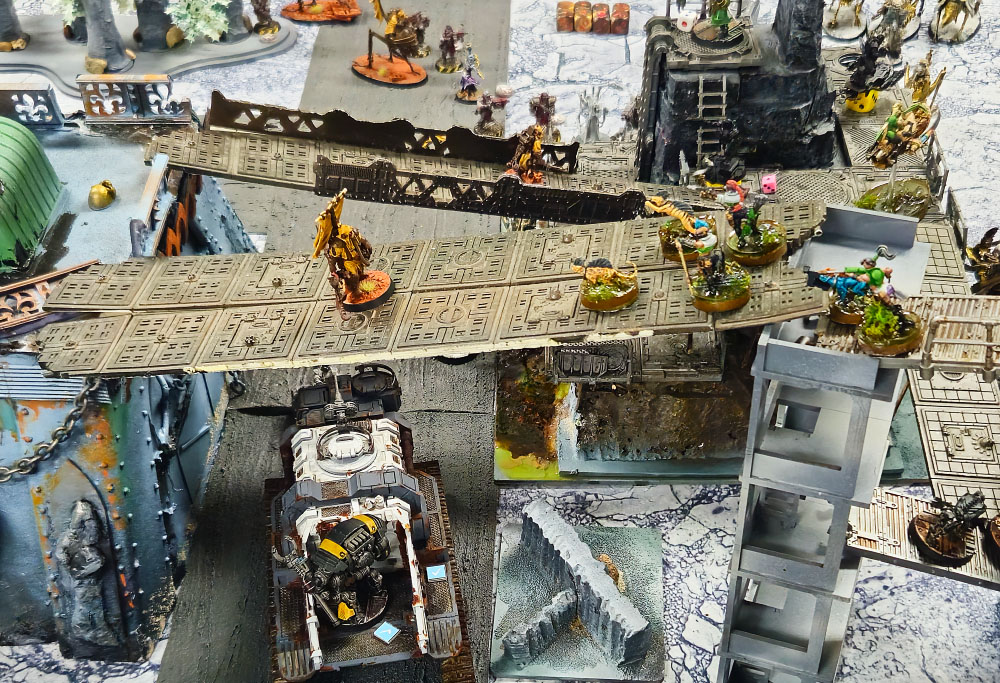
The possibilities are endless, but the most important thing is that the multiplayer scenario should be fun. There are a few clear types of multiplayer scenarios:
- Free-for-all: Gangs are against each other! Though temporary alliances could happen.
- Factions: Each side represents a different faction in a campaign (e.g., Lady Credo’s Rebellion vs. The Imperial House).
- Treasure Hunt (or Monster Hunt): The Arbitrator controls some elements or models on the board (e.g., the Arbitrator could play the Daemons breaking through the warp in Hive Arcos).
Why Is a Multiplayer Scenario Necessary for Your Campaign?
Besides the obvious fun of getting together with your group, you might want to use the opportunity of a multiplayer scenario for various reasons, both narrative and meta:
- To advance the narrative of your campaign or to focus on a crucial point (e.g., hunting a daemon).
- To distribute unallocated Territories, which could be rewards for the top three players of your multiplayer scenario.
- To provide an incredible challenge for a gang that has become too powerful.
After that, you want the multiplayer scenario to serve your campaign and its narrative.
When is the Best Moment to Organise a Multiplayer Game?
There are three ideal occasions to organise such a game. They fit quite naturally into a campaign, allowing players to bond and rivalries between gangs to develop. The three best moments are:
- The first game of a campaign. Starting a campaign with a multiplayer game is just the ideal way to have all your players meet each other and have rivalries between gangs naturally forming right from the start.
- As a Downtime game, during the Downtime phase of a campaign, this is a great way of gathering everyone and this can serve your campaign by driving the narrative forward!
- The final game is the perfect game to decide the fate of the campaign, with a clear objective that will bring factions against each other. It’s the perfect moment to add some specific rules to balance out the factions if needed.
And I should add a 4th best moment:
- The Weekender game, because you don’t need to be in a campaign to play a multiplayer game!
Who is Likely to Attend?
This question brings up more considerations than you might think. You’ll have players with various playstyles joining your campaign. Some are power gamers, some live for the lore, some enjoy experimenting, and some simply want cinematic moments to happen. Most likely, your players are a combination of all these traits.
While they might find ways to enjoy their own games when playing against a single adversary, you’ll need to consider the melting pot they represent when they come together for a multiplayer game. The goal is to ensure everyone has fun!
Making a Multiplayer Game Enjoyable by Everyone
A multi-player game, as an event, will inevitably involve some level of competition. However, it’s crucial to maintain a balance and ensure that all players can enjoy the game throughout. Having a player eliminated in the first round is a terrible outcome.
There is one truth about multi-player games. Being tabled early is NOT fun. It doesn’t teach you anything or add to your experience; you just become a spectator. This can feel even worse if you’ve paid to play at a venue. Unlike a 1v1 game, where you can quickly start another match if you’re defeated, being out early in a multi-player game leaves you alone and sidelined.
As an Arbitrator, it’s important to ensure everyone has at least a few rounds of fun, within reason of course, you’re not here to tell people how to play.
Things to consider:
- The Infiltrate skill: In a multi-player game with a limited crew size, this skill is extremely overpowered. RAW, the fighter could be deployed right at the objective or next to an underpowered gang, eliminating them all in one go. This would unfairly eliminate another player early on.
- Random crew size: Do not leave crew size to chance. If you allow it to be random at the start of a multi-player scenario, one player might roll a 1 on their D3 crew while others roll a 3. Since each round takes time to go through all players, the player with a smaller crew will likely end up bored and on their phone during each round. Hard to blame them!
- Random Fighters: Avoid randomising fighters. Similar to crew size, if one player ends up with a Juve while others get their leader or champions, it’s not just a matter of odds. It condemns that player to be knocked out early and go home.
If despite everything, a player gets knocked out early, if your scenario allows it, you can offer them the opportunity to control some part of the game with you – such as zombies, daemons, other NPCs, or battlefield events. Invite them to play alongside and roll some dice.
Number of Players and Number of Models
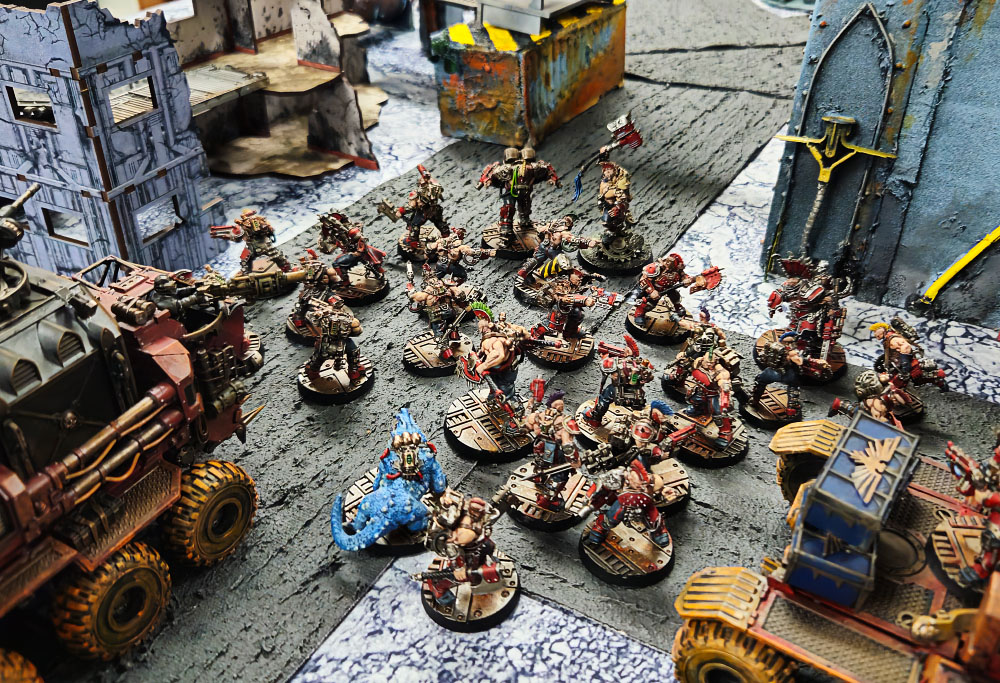
The number of players and the number of models significantly influence the game’s duration. If you aim to keep your multiplayer game under 3 hours, here’s my recommended ratio of models per player:
| Number of Players | Crew Size | Total number of model |
|---|---|---|
| 2 | 9 | 18 |
| 3 | 7 | 21 |
| 4 | 5 | 20 |
| 5 | 4 | 20 |
| 6 | 3 | 18 |
| 7 | 3 | 21 |
| 8 | 2 | 16 |
How to Streamline each round?
If you feel the need to streamline each round, you can achieve this with some tailored house rules for the occasion. Below is a list of possible rules you could consider. You probably won’t need to use all of them simultaneously, depending on the number of miniatures on the table at the start.
Option 1: Modify the Group Activation Rules
One effective way to speed up a multiplayer game is by adjusting the Group Activation rule or which fighters can activate together, or if Group Activation are mandatory. Depending on the number of miniatures, you could implement one of the following tweaks:
- Leaders and Champions can activate one more Fighter than they are normally authorised to, up to 6″.
- Leaders and Champions must group activate with at least one Fighter.
Option 2: Use the Coordinated Attacks rule from Apocrypha Necromunda: Hive Blood
COORDINATED ATTACKS
In Age of the Gang Kings, players may activate fighters (not vehicles) with the Gang Fighter (X) special rule in groups, provided they are close to each other. When a player activates a fighter with the Gang Fighter (X) special rule, they may also activate any other friendly fighters with the Gang Fighter (X) special rule within 6″ of that fighter (treat this as if the fighters had been activated using a Group Activation).This does not affect Group Activations made by Champions and Leaders.
Option 3: Seriously Injured Fighters are considered OOA
This option works differently as it proves effective in speeding up the game gradually. With this tweak, you adjust how Seriously Injured Fighters are handled:
- A Seriously Injury result on the Injury dice equals an Out of Action result.
In Apocrypha Necromunda: Hive Blood, they wrote the rule in a way that’s less clear to players generally but achieves the same result:
Fighters reduced to 0 wounds are removed from play.
Deployment and Priority
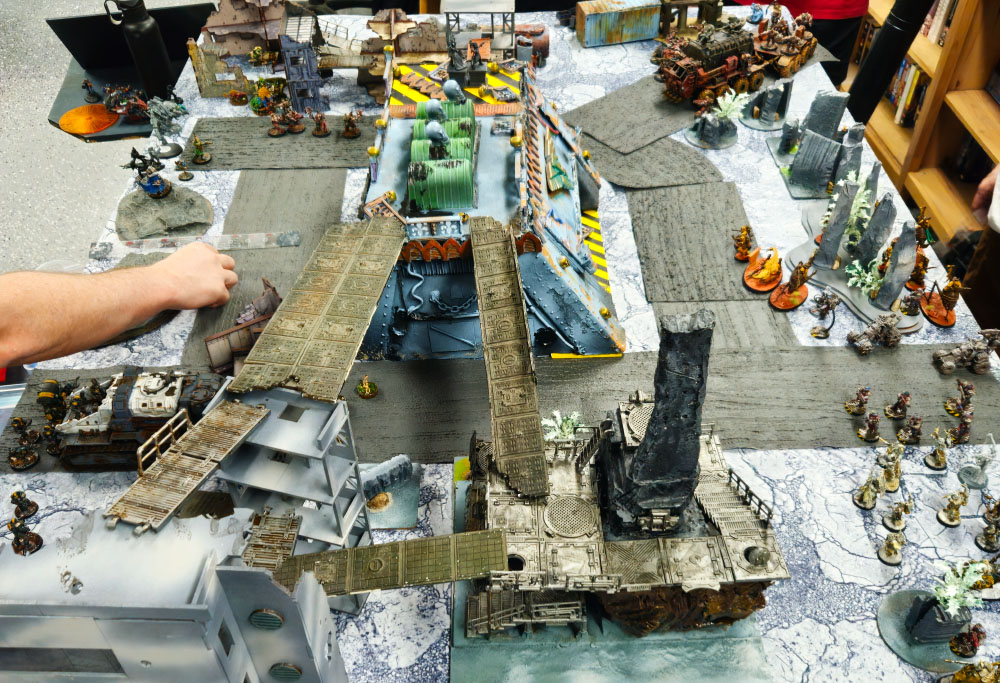
Alright, you’re gearing up to start your game and suddenly you’re wondering, how can you handle deployment and priority? I’ve played multiplayer games ranging from 3 players to as many as 10 players, and things can get messy if you strictly follow the standard rules. So first, let’s take a look at what the standard rules recommend.
I’ve only seen it mentioned in the Necromunda Rulebook (2018):
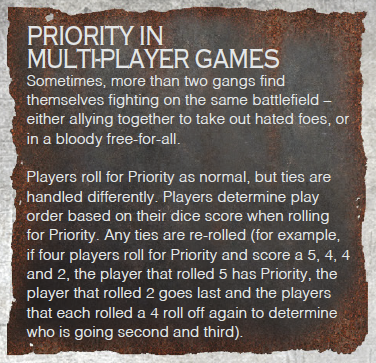
If you stick with this ruling and have more than three players, things will quickly become confusing as everyone will forget at what point whose turn it is.
So, how can you deal with that in a practical manner that will just make sense and make this multiplayer game more of a nice event rather than a big headache?
Recommended Deployment
For deployment, each player rolls a D6. Reroll any ties until you establish a clear order of players. The player with the highest roll chooses a position in the available deployment zone(s) and deploys their models. The next player in the order does the same. Each player positions themselves closest to their models around the board.
Priority Order
Once everyone has deployed their models and is standing next to their deployment zone, you’ll have a defined order for priority for the whole game. That’s also when you have to decide whether priority will go clockwise (or counterclockwise, as preferred). However, you’ll have to agree altogether to stick to one direction for the whole game before rolling for priority.
Roll for Priority
Now, it’s time to roll for priority! Remember, players take turns in a specific order determined earlier. The only thing that matters is who rolls the highest priority, as they will start the round before passing play to the next player around the board.
In subsequent rounds, in the case of a tie when determining who has the highest roll, the player who had Priority in the previous round cannot contest it, priority goes to the other player. If multiple players tie, reroll among those who didn’t have priority in the previous round. Done!
Protip: if you want to reduce the number of ties to determine the highest roll between players, you can roll 2D6 instead of a single D6. This should cut the overall probability of a tie by ~2.
E.g. for 6 players, on the first round:
- ~46% per round of a tie for the highest roll on a D6.
- ~24% per round of a tie for the highest roll on 2D6.

